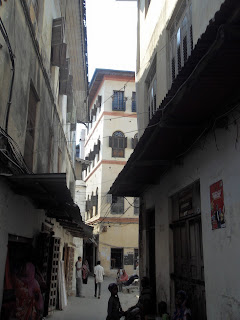
Another ever presence are the mostly young men who venture into traffic to sell their wares at car windows. We learned that they are called ‘machingas’ which is the Swahili version of ‘marching guys.’ We were also informed that with them and most of the roadside sellers one must reduce the stated price by half, perhaps even more if one is a Mzungu. On our bus to Mikumi people bought air time in this way, roasted cashews and peanuts, cassava or potato chips, soft drinks, newspapers, baskets and fruit. We also found many sellers with stands on the side of the road, especially nearer to Mikumi, with many different baskets, with an eye to the tourists going to the national park. Also sugar cane and coconuts, of course.






 The heart of the island of Zanzibar is the historic district of Stone Town, known for its narrow alleys, beautifully carved doors, aromatic spices, and now filled with small shops geared to the many visiting tourists. We stayed at a nice place near to the harbor called the Abuso Inn. After our busy afternoon and evening on Friday, we followed a nice breakfast on Saturday morning by walking all through Stone Town. We were told that it would be impossible to get lost in the narrow alleyways, because eventually one always finds one’s way to the sea on one side, or Creek Road on the other. Kuno, Mave, Shireen and I spent hours being tourists, snapping pictures and moving from one small shop to another.
The heart of the island of Zanzibar is the historic district of Stone Town, known for its narrow alleys, beautifully carved doors, aromatic spices, and now filled with small shops geared to the many visiting tourists. We stayed at a nice place near to the harbor called the Abuso Inn. After our busy afternoon and evening on Friday, we followed a nice breakfast on Saturday morning by walking all through Stone Town. We were told that it would be impossible to get lost in the narrow alleyways, because eventually one always finds one’s way to the sea on one side, or Creek Road on the other. Kuno, Mave, Shireen and I spent hours being tourists, snapping pictures and moving from one small shop to another.









































